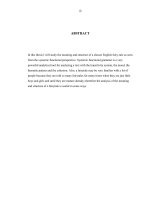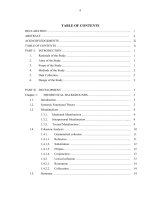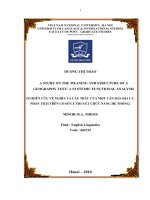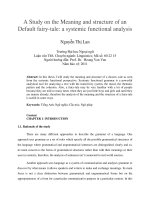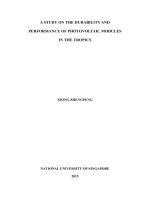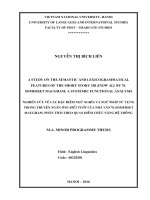a study on the forms and meanings of lexical verb get and vietnamese equivalents nghiên cứu hình thái và ngữ nghĩa của động từ get và những tương đương trong tiếng việt
Bạn đang xem bản rút gọn của tài liệu. Xem và tải ngay bản đầy đủ của tài liệu tại đây (1.02 MB, 46 trang )
VIET NAM NATIONAL UNIVERSITY, HA NOI
UNIVERSITY OF LANGUAGE & INTERNATIONAL STUDIES
FACULTY OF POST – GRADUATE STUDIES
*****************
ĐẶNG THỊ THÙY VÂN
A STUDY ON THE FORMS AND MEANINGS OF LEXICAL
VERB ‘ GET ’ AND VIETNAMESE EQUIVALENTS
( NGHIÊN CỨU VỀ HÌNH THÁI VÀ NGỮ NGHĨ A CỦA ĐỘNG TỪ ‘
GET ’ VÀ NHỮNG TƯƠNG ĐƯƠNG TRONG TIẾNG VIỆT )
MINOR M.A. THESIS
Field : English Linguistics
Code : 602215
Hanoi – 2010
VIET NAM NATIONAL UNIVERSITY, HA NOI
UNIVERSITY OF LANGUAGE & INTERNATIONAL STUDIES
FACULTY OF POST – GRADUATE STUDIES
*****************
ĐẶNG THỊ THÙY VÂN
A STUDY ON THE FORMS AND MEANINGS OF LEXICAL
VERB ‘ GET ’ AND VIETNAMESE EQUIVALENTS
( NGHIÊN CỨU VỀ HÌNH THÁI VÀ NGỮ NGHĨ A CỦA ĐỘNG TỪ ‘
GET ’ VÀ NHỮNG TƯƠNG ĐƯƠNG TRONG TIẾNG VIỆT )
MINOR M.A. THESIS
Field : English Linguistics
Code : 602215
iv
TABLE OF CONTENTS
Page
DECLARATION
i
ACKNOWLEDGEMENTS
ii
ABSTRACT
iii
TABLE OF CONTENTS
iv
ABBREVIATIONS
vii
PART I
INTRODUCTION
1
1. Rationale of the study
1
2. Aims of the study
2
3. Research questions
2
4. Scope of the study
2
5. Methodology of the study
3
6. Design of the study
3
PART II
DEVELOPMENT
4
CHAPTER 1 THEORETICAL BACKGROUND
4
1. Clause patterns and elements
4
1.1. Verb
4
1.2. Subject
5
1.3. Object
5
1.3.1. Direct object
5
1.3.2. Indirect object
5
1.4. Complement
5
1.5. Adverbial
6
2. English Verbs
6
2.1. Forms of verbs
6
2.2. Major grammatical categories
7
2.2.1. Tense and aspect
7
2.2.2. Voice
8
2.2.3. Mood
8
2.3. Classifications of English verbs
9
v
2.3.1. Classified by their functions
9
2.3.2. Classified by their meanings
9
2.3.3. Classified by the number of constituents
9
2.3.4. Classified by their complementation
10
2.4. Verb phrases in English
10
2.4.1. Finite and non-finite verb phrases compared
10
2.4.2. Simple finite verb phrases
11
2.4.3. Complex finite verb phrases
12
2.4.3.1. Intensive verbs
12
2.4.3.2. Transitive verbs
12
2.4.3.3. Monotransitive verbs
12
2.4.3.4. Ditransitive verbs
12
2.4.3.5. Complex transitive verbs
13
3. Vietnamese Verbs
14
3.1. Classification
14
3.2. Verb phrases in Vietnamese
15
4. Contrastive analysis
17
CHAPTER 2 THE OCCURRENCES OF LEXICAL VERB ‘ GET ’
IN ENGLISH WITH VIETNAMESE EQUIVALENTS
18
1. Communicative functions expressed via the lexical verb Get in clause
pattern SVO
18
1.1. to receive or obtain something
18
1.2. to fetch something
20
1.3. to catch illness
20
1.4. to use form of transportation
21
1.5. to have revenge on somebody
21
1.6. to buy something
22
1.7. other meanings
22
2. The lexical verb Get in clause pattern SVOO
23
3. The lexical verb Get in clause pattern SVC
24
3.1. Some common adjectives as Complement
24
vi
3.2. Some common participles as Complement
25
4. The lexical verb Get in clause pattern SVOC
27
5. The lexical verb Get in clause pattern SVA
29
6. The lexical verb Get in clause pattern SVOA
30
7. The lexical verb Get in clause pattern SV
30
CHAPTER 3 FINDINGS AND DISCUSSION
32
1. Similarities and differences in the lexical Get in English versus Vietnamese
equivalents
32
1.1. Similarities
32
1.2. Differences
33
2. Errors and mistakes commonly committed by Vietnamese beginners of
English and some possible solutions
34
1.1. Get as a linking verb ( copula verb )
34
1.2. Get used with a past participle ( in pattern SVC )
34
1.3. Get used with a past participle ( in pattern SVOC )
35
1.4. Got / Gotten alternation
35
PART III
CONCLUSION
36
1. Conclusions
36
2. Recommendations for further research
37
REFERENCES
38
APPENDICES
APPENDIX A: Notes of usage on some common copula verbs.
APPENDIX B: The list of verb phrases which are quite frequently passive in form but
active in meaning.
APPENDIX C: The list of verb phrases which are often active in form but passive in
meaning.
APPENDIX D: The comparison of have + O + pp with get + O + pp.
APPENDIX E: The use of have / have got / have gotten.
vii
ABBREVIATIONS
A
Adverbial
A. P
Adverb Phrase
A
dj.
Adjective
A
dj
. P
Adjective Phrase
AE
American English
BE
British English
cf.
compare
C
Complement
L
1
First language
L
2
Foreign language
N
Noun
NP
Noun Phrase
O
Object
O
d
Direct object
O
i
Indirect object
Prep. P
Prepositional Phrase
S
Subject
V
Verb
VP
Verb Phrase
Ø
Zero
*
Unacceptable structure
1
1
PART I INTRODUCTION
1. Rationale of the study
Nowadays, English is regarded as the language of modernization and technological
advancement all over the world. Learning English is also problematic for native speakers
in general and foreign learners in particular because they are affected by their mother
tongue during the process of studying grammar, vocabulary, spelling, pronunciation, etc.
On the part of grammar, Verbs have always been one of the most complex classes
of words, which have most widely used and consequently, have played an important role
in any language system so far. Among English verbs, Get is one of the commonest words
and is used in many different ways.
Conducting the minor thesis entitled “ A Study on The Forms and Meanings of
Lexical Verb ‘GET’ and Vietnamese Equivalents ” arose as a result of difficulties that
the author face in her daily teaching related to the usage of this verb. The problem she has
to wrestle with involves various questions that elementary-level students ask concerning
the usage of get in different clause patterns and in different context.
For the above reason, this thesis has been made with an attempt to contribute the
author‟s own knowledge and experience in dealing with the problems of Vietnamese
beginners. It‟s also hopeful that this minor thesis will be of some help to those who are
interested in this aspect of English grammar.
2. Aims of the study
The thesis is to be focused on:
* Different forms and meanings exhibited by Get and Vietnamese equivalents.
* Similarities and dissimilarities in terms of meaning between English and
Vietnamese.
* Common mistakes likely committed by Vietnamese beginners of English and
some possible solutions.
3. Research questions
To fully achieve these aims, the study should answer the following questions:
(i) How is Get exhibited in different clause patterns ?
2
2
(ii) How are they similar and different in terms of meaning between English and
Vietnamese ?
(iii) What are common mistakes likely committed by Vietnamese beginners of English
and how to solve them ?
4. Scope of the study
Since the verb get goes largely unnoticed, and yet in conversation it is the single
most common lexical verb in any one register, it is viewed as a broad subject to discuss.
However, its meaning depends on what kind of words comes after it; such as: noun,
pronoun, adjective, adverb, past participle, object, infinitive, etc … I just try to focus on
the seven basic clause patterns in which get occurs and its polysemy; therefore, occurrence
of get in idiomatic multiword phrases as „get away with‟ or „get rid of ‟ will not be treated
much here.
5. Methodology of the study
In order to deal with the subject effectively, a flexible combination of methods is
employed.
- The study is carried out basically through the descriptive and contrastive analysis. The
descriptive method is utilized to give in depth and detailed description of forms and
meanings of get. Then examples which are provided to illustrate the description will be
derived from the grammar materials and reference books written by contemporary
influential linguists in English as well as bilingual written publications available in
Vietnam. The sources of data also comprise various genres: novels, stories,
advertisements, leaflets, notices, signs and the like. Besides, the translational equivalence
will be chosen to serve as tertium comparationis for the contrastive analysis. The pair of
sentences are juxtaposed in order to show the contrast between the two languages. All the
examples in the thesis will be translated word by word so that the features of get will be
highlighted.
- The supporting methods include qualitative methods, which is used for collecting data
and interpretative analysis, which is used to analyze the data collected.
The procedures of the study are:
3
3
- To collect relevant data and rearrange systematically.
- To synthesize meanings of get from various sources.
- To analyze and contrast so that the similarities and differences will be seen through the
way this verb get parceled out correspondingly in Vietnamese.
6. Design of the study
This minor thesis consists of 3 main parts based on the following arrangement:
Part I entitled „INTRODUCTION‟ outlining the background of the study in which
brief account of relevant information such as the rationale, aims, research questions,
scope, methodology and design of the study are provided.
Part II , the „DEVELOPMENT‟ is subdivided into 3 chapters. Chapter 1 supplies
the general fundamental and essential theoretical concepts involving the subject under
consideration. Chapter 2 presents and describes concrete cases related to the lexical verb
get in a contrastive analysis with the Vietnamese translation equivalents, together with the
transfer rules identified in formulas. Chapter 3 is about the findings and discussion
resulting from the study.
Part III is the „CONCLUSION‟ offers the overview of the major conclusions on
each of the objectives set forth as tasks assigned to the research, which is followed by
some suggestion for further research.
REFERENCES come at the end of the paper, closing with Appendix.
4
4
PART II DEVELOPMENT
CHAPTER 1 THEORETICAL BACKGROUND
1. Clause elements and clause patterns
The clause is the key unit of syntax, capable of occurring independently. The
following list presents examples of the basic clause patterns.
(1) Type SVC
S V
intensive
C
Mary is kind
a nurse
(2) Type SVA
S V
intensive
A
place
Mary is here
in the house
(3) Type SV
S V
intransitive
The child was laughing
(4) Type SVO
S V
monotransitive
O
d
Somebody caught the ball
(5) Type SVOC
S V
complex-transitive
O
d
C
o
We have proved him wrong
a fool
(6) Type SVOA
S V
complex-transitive
O
d
A
place
I put the plate on the table
(7) Type SVOO
S V
ditransitive
O
i
O
d
She gives me expensive presents
Clause elements are phrases that serve syntactic roles in the clause. According to
Quirk et al ( 1972 : 35-40 ), there are five elements of clause ( or sentence) structure which
are normally obligatory: Subject (S), Verb (V), Complement (C), Object (O), and
Adverbial (A).
1.1. Verb
The term Verb (V) stands for a verb phrase in a sentence. The verb phrase ( or
„predicator‟ ) is the central element of the clause, because it expresses the action or state to
5
5
which other elements relate, and it controls the other kinds of elements and meanings that
can be in the clause. The VP was described in ( 2. English Verb ) of this chapter, so
nothing further needs to be said here.
1.2. Subject
The second most important element is the subject. Syntactically, the Subject (S)
can be a noun phrase or a clause nominal function. It occurs before the verb phrase in
declarative sentences and immediately after the operator in interrogative sentences.
Moreover, it determines the number of the VP, depending on whether the subject is
singular or plural. Semantically, it denotes the most important participant in the action or
state denoted by the verb. With transitive verbs, this is generally the „doer‟ or agent of the
action. Besides, it generally represents the topic, i.e. the entity that the clause is about. But
sometimes English requires a subject, even if the subject has no actual meaning.
e.g. It is warm in here. ~ Sarah and Michael disappeared.
1.3. Object
The Object is a noun phrase or a clause with nominal function. It normally follows
the verb and only occurs with transitive verbs. By the passive transformation, it assumes
the status of subject. There are two kinds of objects: direct and indirect.
1.3.1. Direct object ( O
d
)
A direct object generally follows immediately after the verb, except where an
indirect object intervenes. Its most common semantic role is to denote the entity affected
by the action or process of the verb.
e.g. Your dog‟s got brown teeth. ~ We parked the car in the worst place.
1.3.2. Indirect object ( O
i
)
An indirect object occurs after ditransitive verbs such as give / tell / …, and comes
before the direct object. It conforms to the other criteria for objects, including the
formation of passives. As for their semantic role, indirect objects generally denote people
receiving something or benefiting from the action of the verb.
e.g. Well actually he brought us the big menu first. ~ I cooked the kids dinner.
1.4. Complement
The Complement ( subject or object ) is a noun phrase, an adjective phrase, or a
clause with nominal function. It follows the subject, verb phrase, and ( if one is present )
6
6
object. Unlike the object, the complement does not become subject through passive
transformation.
e.g. Her hobby is playing chess. ~ Mary is very clever.
1.5. Adverbial
The Adverbial is an adverb, adverb phrase, adverbial clause, noun phrase or
prepositional phrase. Some verbs take an adverbial in order to complete their meaning,
known as obligatory adverbial. It can occur with two patterns: copular and complex
transitive. It usually express place or direction although it can also express time or manner
meanings.
e.g. I treated her badly, very badly. ~ Your toast is on the table.
The other kind, optional adverbial, add additional information to the clause,
covering a wide variety of meanings, such as place, time, manner, extent, and attitude.
Therefore, it may be added to or removed from a sentence without affecting the
acceptability of the sentence. In terms of position, it is generally mobile, i.e. it is capable
of occurring in more than one position in the clause.
e.g. I only get one today. ~ I was here, with uncle Nick, thirty years ago.
2. English Verbs
In this part, the following areas will be taken into account: forms of verbs, major
grammatical categories and classifications of English verbs.
2.1. Forms of verbs ( lexical verbs )
As Radndolph Quirk & Sidney Greenbaum (1973:26) put it:
„Many English verbs have five forms: the
base
, the
–s form
, the
past
, the
–ing
participle
and the
–ed participle
.‟
Example of these forms are given in the table below:
Symbol
Regular verbs
Irregular verbs
Base form
-s form
past form
-ing participle
-ed participle
V
V-s
V-ed
1
V-ing
V-ed
2
play
plays
played
playing
played
steal
steals
stole
stealing
stolen
get
gets
got
getting
got / gotten
cut
cuts
cut
cutting
cut
7
7
Some of the verb forms have more than one use / function.
Base form
All the present tense
Imperative
Subjunctive
The infinitive
You play very well. ~ They call every day.
Play tennis with me.
He demanded that she call and see him.
I‟d like to play ~ He may call.
-s form
3
rd
person singular present
Simon plays very well.
past form
Past tense
He called yesterday. ~ They played chess.
-ing participle
Progressive aspect
In ing participle clauses
He‟s calling in a moment.
Calling early, I found her at home.
-ed participle
Perfect aspect
Passive voice
In ed participle clauses
He has played back the film.
The film was played back.
Called early, he had a quick breakfast.
2.2. Major grammatical categories
The English verb has main grammatical categories such as: tense – aspect – voice
– mood. Firstly, something should be discussed about time. Time is a universal concept
with three divisions:
past time present time future time
×
2.2.1. Tense and aspect
Tense is the relationship between the form of the verb and the time of the action or
state it describes. Many modern grammarians claim that in the English language, verbs
have two tenses: the present tense, which normally refers to present time and the past
tense, which refers to past time. For example:
She is quite well today. ~ Yesterday she was sick.
There is no obvious future tense in English corresponding to the time. Instead,
there are a number of possibilities of denoting the future time.
- Auxiliary verb construction is used to express an action happening in the future :
She will be here in half an hour.
- „Be going to + infinitive‟ is used to denote future intentions : When are you going
to get married ?
- The simple present is used in the subordinate clause of conditional sentence: If you
leave now, you will never regret it.
8
8
- The present progressive refers to a future happening anticipated in the present. Its
basic meaning is „fixed arrangement, plan or program‟: The orchestra is playing Mozart.
With reference to aspect, there are four: simple, perfect, progressive and perfect
progressive. Tense and aspect are combined to form a system of eight tenses as presented
in the following table:
Tense
Aspect
Simple
Perfect
Progressive
Perfect progressive
Present
V / V-s
Be: is, am, are
have / has
+ V-ed
am/ is / are +
V-ing
have / has + been +
V-ing
Past
V-ed
Be: was, were
had + V-ed
was / were +
V-ing
had + been + V-ing
2.2.2. Voice
Voice is the way in which a language expresses the relationship between a verb
and the noun phrase which are associated with it. It is voice that makes it possible to view
the action of a sentence in two ways without change in the facts reported. However, there
may be a change in emphasis and one type of sentence may be more appropriate. For
example, in: „The wind damaged the fence‟. „The wind‟ is the subject of the verb
„damaged‟, which is in the active voice; while in: „The fence was damaged by the wind‟.
„the fence‟ is the subject of the verb „was damaged‟, which is in the passive voice.
Verb types not employed in passivization include intensive verbs, monotransitive
verbs, verbs of suiting ( fit, suit, … ), verbs of resemblance ( look like, … ) and verbs of
possession ( possess, have, own, … ).
2.2.3. Mood
In English, there are three moods: indicative, imperative and subjunctive, which
are illustrated in the following table:
Mood
Realization
Examples
Indicative
by the form of the verb in declarative sentences or
questions.
She sat down.
Are you coming ?
Imperative
by the form of the verb in imperative sentences
Be quiet !
Subjunctive
by the form of the verb often used to express
uncertainty, wishes, desires, …
I demand that he come
at once.
9
9
2.3. Classifications of English verbs
There are many different ways to classify English verbs, maybe according to
functions, forms, meaning, complementation or the number of constituents. Due to the
scope of this minor thesis, some ways to classify English verbs will be exhibited more
clearly as follows:
2.3.1. Classified by their functions
From V.D.Quang‟s view in „Lectures on English Grammar‟ (2006:16), Verbs are
classified according to the functions performed by the elements in the verb phrase:
Regular : V V-ed
Lexical
Irregular : ( 7 subclasses )
Verbs Semi-auxiliaries : need, dare, used to
Primary : do , have, be
Auxiliary
Modal : will, would, shall, should, may, might, ought to,
must, can, could
2.3.2. Classified by their meanings
Distinctions between verbs need to be drawn in relation to whether they themselves
admit the aspectual contrast of „progressive‟ and „non-progressive‟. When verbs ( either
habitually or in certain uses ) will not admit the progressive, they are called Stative; when
they admit it, they are called Dynamic. It is normal for verbs to be dynamic and even the
minority that are almost always stative can usually be given a dynamic use on occasion.
For instance:
The girl is now a student at a large university.
not * The girl is now being a student at a large university.
2.3.3. Classified by the number of constituents.
One-word verbs
Verbs Phrasal verbs : verb + particle
Multi-word verbs Prepositional verbs : verb + preposition
Phrasal-prepositional verbs : verb + particle + preposition
10
10
e.g. We learn English every day. ( one-word verb )
She turned on the radio. ( phrasal verb )
She looked at the radio. ( prepositional verb )
They put up with the noise. ( phrasal-prepositional verb )
2.3.4. Classified by their complementation.
Current : be, seem, remain, keep, …
Intensive ( SVC / SVA )
Resulting : become, turn, go, get, …
Verbs
Intransitive ( SV )
Extensive Monotransitive ( SVO )
Transitive Ditransitive ( SVOO )
Complex transitive ( SVOC / SVOA )
e.g. She is clever. ( current intensive )
Her face went red. ( resulting intensive )
Mary sings well. ( intransitive )
Mary beat Tom hard. ( monotransitive )
I gave Tom a book. ( ditransitive )
Tom made me angry. ( complex transitive )
2.4. English Verb Phrases
In Longman Dictionary of Applied Linguistics (1985:306), the verb phrase is
defined as the part of a sentence which contains the main verb and also any object(s),
complement(s), and adverbial(s). For example, in Tom gave a watch to his son all the
sentence except Tom is the verb phrase.
On the other hand, Biber D. et al (2008: 42) states that Verb phrases have a lexical
verb or primary verb as their head ( i.e. their main verb ). The main verb can stand alone
or be preceded by one or more auxiliary verbs. The auxiliaries further define the action,
state or process denoted by the main verb. Morphologically, verb phrases are divided into
the finite verb phrase and the non-finite verb phrase.
2.4.1. Finite and non-finite verb phrases compared
According to V.D. Quang (2006:17), the five forms of the verb phrase are
11
11
exhibited as following:
V
Vs Finite
V-ed
1
V-ed
2
Non-finite
V-ing
Sharing the same view with V.D.Quang, T.H.Manh (2007:112), the verb forms
operate in finite and non-finite verb phrases which are distinguished as follows:
Finite verb phrases
Non-finite verb phrases
1
can occur as the predicate of an independent clause
Ø
2
have tense distinction, i.e. present and past tense to
express grammatical time relations
Ø
3
exist concord in number and person, especially with
be. With other lexical verbs, there is a contrast
between 3
rd
and non-3
rd
person singular present.
Ø
4
have moods: indicative, imperative and subjunctive
Ø
5
have a finite verb form, i.e. either an operator or a
simple present or past tense form
consist of one or more non-
finite forms of the verb. They
often occur as S, O, C or A in
main clause
Let‟s compare two sets:
Finite verb phrase
Non-finite verb phrase
studies
studied
He is studying English.
was studying
He had been offended before.
Studying is useful.
It is useful to have studied English.
To smoke like that must be dangerous.
I found him working.
Having been offended before, he was sensitive
2.4.2. Simple finite verb phrases
The finite verb phrase is simple when it consists of only one verb, which may be
imperative, present or past. For example:
Work harder ! ~ He works hard. ~ He worked hard.
12
12
2.4.3. Complex finite verb phrases
The complex verb phrase consists of two or more verbs in which the lexical verb
follows the auxiliary verb(s). The lexical verb is the verb phrase head. As the introduction
in 2.3., there are five classes of lexical verbs. Different kinds of verbs make different verb
phrases and also the range of combinations.
2.4.3.1. Intensive verbs
The intensive verbs, or copula verbs, are used to join a noun, a pronoun, an
adjective to the subject for a sentence, such as: be, feel, look, seem, remain, appear,
become, turn, grow, fall, get, go, come … They can only be in the active voice form, and
noun phrases following them are never objects. The NPs are complement and have
different semantic functions. The sentence patterns of these verbs are SVC and SVA.
She gets older. ~ He was in the house.
2.4.3.2. Intransitive verbs
An intransitive verb cannot take an object and make complete sentences by itself
( although there can be noun phrase or prepositional phrase after it, they are not object
because these can be shifted ). The sentence pattern is SV.
The man was waiting ( at the side of the road ). ~ They arrived ( the next day ).
2.4.3.3. Monotransitive verbs
These verbs are directly followed by a noun phrase or an embedded clause, it is the
direct object to make the predicate complete. So the sentence pattern of this is SVO.
The girl learns English. ~ The boys climbed the tree.
2.4.3.4. Ditransitive verbs
The ditransitive verb phrase has two argument constituents. The first noun phrase
immediately following the verb normally refers to a living creature, the second to
something nonliving. The sentence pattern here is SVOO. The two objects are direct
object and indirect object. The orders are:
S + V + O
i
+ O
d
or S + V + O
d
+ prep ( to / for ) + O
i
13
13
2.4.3.5. Complex transitive verbs
These verbs following by two noun phrases look as if they are ditransitive but in
fact, they are not. They take the pattern SVOC or SVOA.
The group elected him president. ( SVOC )
They left the room in a good mood. ( SVOA )
If we relate the structure of the non-finite verb phrase to that of the finite verb
phrase, we can tabulate them as follows:
Infinitives
Participles
Simple
to examine
examining
Complex
to have examined
to be examining
to be examined
to have been examining
to have been examined
to be being examined
to have been being examined
having examined
* being examining
being examined
having been examining
having been examined
* being being examined
* having been being examined
The last two non-finite verb phrases ( to have been being examined and having
been being examined ) are rarely used.
14
14
3. Vietnamese Verb
Vietnamese is an isolating and analytic language in which grammatical meanings
are shown chiefly through word order and function words (grammatical words). Also,
Vietnamese words have the same forms in different positions in sentences. As a result,
several grammatical structures are similar in form-organization but different in
grammatical meanings. And Vietnamese verbs are not out of question.
e.g. Tôi đi làm bxe máy. ( I go to work by motorbike. )
Hôm qua tôi đi làm ( Yesterday I went to work by motorbike. )
In Vietnamese Grammar by Huu Quynh (1980), Verb is defined as a word which
refers to an action, a behavior, an idea or an emotion, a state or a development of a state.
Unlike English verbs, verbs in Vietnamese do not have the concord with other
parts of speech. In other words, they are not affected by number, person, gender, mood,
voice and tense. In addition, when functioning as central component of a verb phrase, verb
can combine with other modal auxiliary components before it to indicate scope of the
action or activity such as , , , etc ; to indicate continuation like còn, , etc ; to
indicate tense, aspect such as , , , , etc ; to indicate advice or prohibit such as
hãy, , and so on. Also, as Nguyen Kim Than ( 1977:178 ) states that , ,
, , , … are words indicating aspect – time. It means that they are used to show the
carrying out or completion of an action in a certain time and the use of adverbs of time
belongs to the area of sentence structures. Besides, such words as , , , … which
may be considered a sign of the passive voice by some other grammarians are independent
verbs ( ).
3.1. Classification
In each language, there are different ways to classify verbs, so is Vietnamese.
According to D.Q.Ban and H.V.Thung (1992:91), they classify Vietnamese verbs into two
kinds: independent verbs () and dependent verbs ().
In each major type, he subdivides them basing on several factors. They are summarized in
the following table:
15
15
Classification of verbs
Examples
Meanings conveyed
Independent
Modal
nên, cần, phải, …
necessity
có thể, không thể, …
ability
định, toan, dám, nỡ, …
will
mong, muốn, ước, …
expect
bị, được, mắc phải, chịu, …
passive
cho, xem, thấy,
estimation
Relation
là, làm
parity
còn, có mất, biến, …
existence
có
possession
hóa, thành, hóa ra, …
change
bắt đầu, tiếp tục, …
time process
gần, xa, gần gụi, …
spatial process
giống, khác, hơn, kém,
comparison
Dependent
by Adjunct
followed
viết, đánh, đi, nói, nghe,
action
yêu, ghét, thích, mê, ….
thấy, cảm thấy, …
state
by Notional
words
followed
ngồi, đứng, nằm, lăn, …
ngủ, thức, cười, …
cằn nhằn, hậm hực, …
action ( notional words
needn‟t be required )
( intransitive verbs )
đánh, trồng, học, …
cho, tặng, gửi, lấy, …
sai, bảo, khiến, …
ra, vào, lên, xuống, …
đi, chạy, bò, lăn, …
kéo, đẩy, xô, …
action ( notional words are
usually required )
( monotransitive verbs or
ditransitive verbs )
Source: Diep Quang Ban & Hoang Van Thung, Vietnamese Grammar, p100
3.2. Verb Phrases in Vietnamese
The Vietnamese verb phrase is the enlargement of the verb related to other
components to get a specific function in a sentence. According to Nguyen Tai Can (1996),
the verb phrase is divided into three parts:
16
16
Another Vietnamese linguist, Diep Quang Ban (1989), agrees that the verbal
phrase in Vietnamese consists of three parts: operators ( Op ), the main verb ( main V )
and complementation ( C ).
e.g. Nó bài. ( He is learning the lesson. )
Op main V C
The operator of a verb phrase, as Huu Quynh (1980:112) claims, conveys grammatical
meanings and it has a limited quantity.
e.g. ( He has just come. )
Op main V
e.g. cùng cùng ( They live and study together. )
Op main V Op main V
whereas the complementation indicates lexical meanings and it is very abundant in
quantity with complicated organizations. The complementation can be a noun, a pronoun,
a verb, an adjective or an adverb.
e.g. nói. ( Study how to eat, how to speak. )
main V Op main V Op
e.g. làm. ( force to study and to do work. )
main V Op main V Op
On the surface, the structure of the verb phrase in Vietnamese is similar to that of
the English verb phrase. However, the Vietnamese verb phrase does not have clear-cut
systems like the English one.
Initial component
( phần đầu )
Centre
( trung tâm )
Ending component
( phần cuối )
Verb phrase
17
17
4. Contrastive analysis
From Richards‟ view (1992), Contrastive Analysis ( CA ) is „the comparison of the
linguistic systems of two languages, for example the sound system or the grammatical
system‟.
CA describes similarities and differences among two or more languages at such
levels as phonology, grammar, pragmatics and semantics. The execution of CA involved
two steps which are description and comparison in this order. With regard to the criteria
for comparison, the tertium comparationis (TC) utilized in this paper are the translationally
equivalent sentences which according to James (1980:175) are synonymous with sameness
of meaning. Furthermore, he claims that „For CA we ought to equate L
1
and L
2
forms
which, no matter how they diverge superficially, are semantically and pragmatically
equivalent‟. As a result, all translation equivalences chosen as TC for the CA in this study
are those satisfying James‟ requirements mentioned. The formulation of the translationally
equivalent sentences allows the similarities and differences of clause patterns containing
the lexical verb get in the two languages to be detected. On the basis of the contrastive
analysis done, predictions of certain difficult areas Vietnamese learners may meet when
learning these structures are made. During the process of comparison, there may happen
some cases where they are interpreted by means of communicative translation.
18
18
CHAPTER 2 THE OCCURRENCES OF LEXICAL VERB ‘ GET ’ IN
ENGLISH SENTENCES VERSUS THEIR VIETNAMESE
EQUIVALENTS
As mentioned in the introduction, get is one of the commonest verbs in English;
therefore structurally, it can be detected in seven basic clause patterns presented by Quirk
et al (1972:343). Moreover, get, semantically, conveys a lot of meanings. This chapter is
an attempt to discuss various senses in each kind of basic clause patterns. Due to the
frequent occurrences of get, cases with type SVO are chosen to start, together with
different senses.
1. Communicative functions expressed via the lexical verb Get in pattern SVO.
In type SVO, get functions as a monotransitive, which requires a direct object. By
collecting, synthesizing and analyzing from diversified resources, the general meanings of
the verb get are categorized into 6 basic groups which are described as follows:
to receive or obtain something
As in ( 1995:494), get means „to receive
something / to obtain something / to achieve or be awarded the specified examination
‟. Also, to define this basic meaning, the Wikitionary
generalizes „a verb indicating that somebody obtains, receives, earns, or is given
somethingFor example:
[1]
Christie got the gold medal in the 100 metres.
đoạt được
( 3:494 )
[2]
get channel 5 with that antenna.
bắt được -ten này.
( 31 )
[3]
I passed them all and got A grades in maths and physics.
à còn được
( 6:140 )
[4]
I need to sharpen my skills so I can get a better job.
kiếm được
( 45:102 )
Let‟s consider other examples:
[5]
Good pain-management programs teach people better ways to work and get a good
19
19
được
( 42:112 )
[6]
The teacher opened the window for getting some fresh air in the room.
đón thêm không khí trong lành vào phòng.
( 45:402 )
[7]
More than 400 years later, researchers say they got the same result by dropping
atoms.
có
( 42:199 )
[8]
To help you get health care and avoid financial difficulties in case of sickness,
especially when you contact serious diseases,
được
( 36:174 )
[9]
"It's springtime, and you won't get any more cold weather," the man replied.
-gặp
( 38:286 )
[10]
I seldom get him on the phone.
gọi cho .
( 1:190 )
[11]
I must surely remember to eat the tuna after it gets light.
Ø sáng.
( 35:49 )
It‟s also defined for the meaning of obtaining or receiving an amount of money by
selling something:
[12]
"All I get is fifty for it," he grumbled, "and I wouldn't do it over for a thousand, cold
cash."
lấy 50 thôi - -
( 38:225 )
[13]
get the money.
lấy
( 44:102 )
